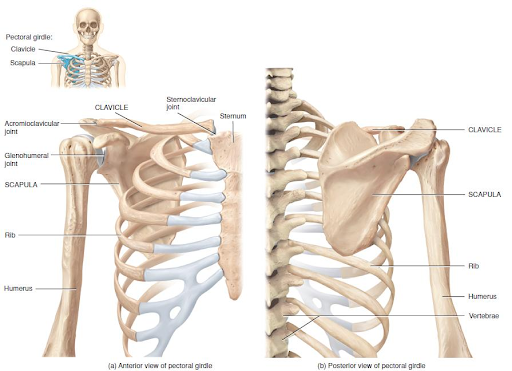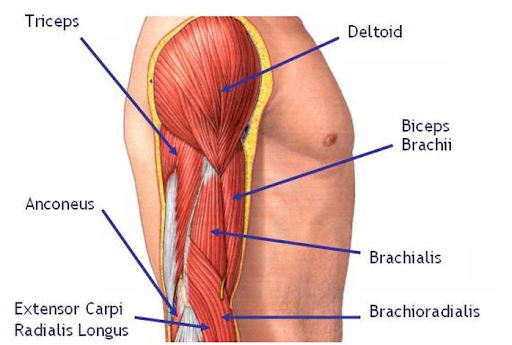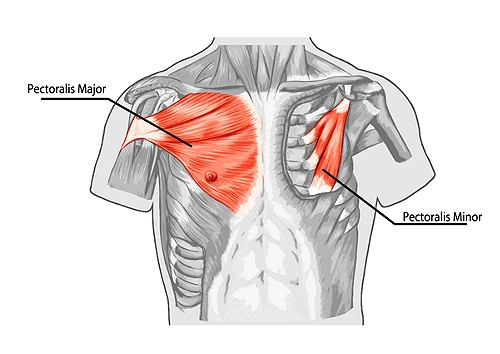All Things Shoulder
We see people at Victory with shoulder issues ALL. THE. TIME. So if you want to learn yourself a little bit more about the shoulder… KEEP READING!
We’ll start with a brief overview of the anatomy and then jump into discussing the underlying causes of pain at the shoulder, using some of the anatomy you just learned. An important distinction here is that we will be focusing on the impairments or deficits causing the pain rather than the anatomical structure that is the source of the pain itself. The reason for this is that the deficits we will focus on can play a part in injury to many different structures in the shoulder, such that many different sources can all have the same underlying causes. This is supported by the research and as well as by what we see here in the clinic.
WHAT’S IN A SHOULDER?
This might seem like a silly question at first, but the area commonly referred to using the overarching term “shoulder” is actually composed of multiple bones and articulations with complex biomechanical relationships. First, the skeletal structure. There are three main bones I want to draw attention to here--the clavicle (aka collarbone), the scapula (aka shoulder blade), and the humerus (aka upper arm bone).
As you can see in the image above, there’s a lot going on there. The joint that people most commonly think of when they refer to the shoulder is the glenohumeral joint, which is the articulation between the humerus and scapula. However, there is also a joint at each end of the clavicle connecting to the acromion of the scapula on one end (the acromioclavicular, or AC, joint) and the sternum on the other (the sternoclavicular, or SC, joint). The SC and AC joints comprise the only true joints linking the shoulder to the rest of the skeleton. Finally, we have one last interaction to mention between the scapula and the rib cage. Although it is called the scapulothoracic joint, this is not a true joint since it lacks a joint capsule or fibrous interconnection, but it is an important biomechanical link nonetheless.
Anatomy lesson part two, the meat of the conversation, muscles. There are too many muscles in the shoulder region to cover them all here, so we will focus on some of the main ones and discuss the others more generally.
The rotator cuff is a group of four muscles that is perhaps most important for maintenance of shoulder stability during movement. The four muscles are the supraspinatus, subscapularis, infraspinatus, and teres minor.
While these muscles do create rotation at the glenohumeral joint, their true function is to hold the humerus firmly in its socket during movements of the shoulder complex. More superficially around the shoulder you will find the deltoid, biceps brachii, and triceps brachii.
Moving to the front, we have the pectoral muscles--both major and minor.
And in the back we have the scapulothoracic muscles, a group that connects the scapula to the thoracic spine and ribs. This group is responsible for stabilizing the scapula and subsequently the socket of the glenohumeral joint that makes up its lateral edge.
One last muscle to draw attention to, the serratus anterior, is another scapulothoracic muscle that sits on the side of the ribcage below the armpit.
The serratus anterior is crucial for any movement of the arm overhead. These muscles all have important functions for mobility and stability at the shoulder. They must work together in a coordinated manner in order fthe shoulder to function optimally and without pain.
WHY DOES MY SHOULDER HURT?
There are lots of different reasons your shoulder might hurt. I am going to break this section down into a few categories. The main causes of pain are related to range of motion (either too much or too little), inadequate strength, and poor motor control/coordination. Each of these can be related to altered movement patterns at the shoulder, increasing susceptibility to injury. Most shoulder pain involves some combination of these three main causes.
Motion
One common thing we see in people coming to us for shoulder pain is large passive range of motion without adequate control throughout that range. If you are someone who tends to think of yourself as “flexible” and can move into all sorts of crazy yoga poses easily, you may fall into this category. Having lots of motion without good control leaves you vulnerable because your shoulder may move into positions that you cannot stabilize, thus placing stress on shoulder structures and possibly leading to injury. I won’t go into specifics here because this kind of hyperflexibility usually affects multiple structures and the answer is to strengthen the areas that are weak while building up full range control and coordination.
On the opposite end of the spectrum is inadequate range of motion. This is more for those of you who are on the “stiffer” side and couldn’t dream of getting into any of those crazy yoga poses other people post on social media. This limitation in range of motion can contribute to shoulder pain by causing structures in the shoulder to be compressed rather than moving together in unison. Mobility restrictions affecting the shoulder can plague the glenohumeral joint, the scapulothoracic joint, the thoracic spine/ribs, or any of the accessory muscles that produce movement at the shoulder. Stiffness of the glenohumeral joint can cause pain both directly through tension on the joint capsule as well as indirectly by causing other structures in the shoulder such as the rotator cuff to become compressed or overused. Limited motion at the scapulothoracic joint is particularly problematic with overhead motions. This is because one third of your overhead shoulder range normally comes from movement of the scapula. When the scapula is unable to contribute its share of the range, the acromion on top of the shoulder fails to move out of the way, possibly causing injury to tendons of the rotator cuff or biceps. Poor thoracic spine extension can also indirectly cause issues at the shoulder. In order to achieve full overhead shoulder motion, some extension (or backbend) must occur in the thoracic spine. When this extension does not occur, you can again end up with compression or overexertion of structures in the shoulder. Finally, tightness in muscles surrounding the shoulder can impact overall motion and result in aberrant movement patterns. Some important areas of restriction are the infraspinatus, teres minor, pectoral muscles, subscapularis, and the levator scapulae. This restriction can be a combination of muscular hyperactivity (often related to overuse, muscle imbalance, or motor control deficits) or tightness (typically related to underuse or prolonged time spent in a particular posture or position).
Strength
The vast majority of shoulder pain cases we see involve weakness in one or more key muscles around the shoulder. The rotator cuff is an obvious first choice when looking for weakness potentially contributing to shoulder pain. As mentioned above, the primary role of the rotator cuff is to stabilize the glenohumeral joint during movement by maintaining centration of the humeral head in the glenoid socket (it keeps the “golf ball on the tee”). Another key area of weakness that is frequently involved is the scapulothoracic muscle group that makes up the upper back - namely the middle trapezius, lower trapezius, and rhomboids. These muscles function to assist with movement of the scapula while raising the arm overhead and are also responsible for holding the scapula stable giving the shoulder a sturdy base from which to move. Finally the serratus anterior, another commonly implicated muscle in the scapulothoracic group. This muscle is primarily responsible for working together with the upper trapezius and lower trapezius to drive scapular upward rotation during overhead movements (see below), thus maintaining optimal alignment of the glenohumeral joint.
Motor Control
The final cause of shoulder pain we will discuss is poor motor control. This can definitely be a bit of a chicken or the egg situation as impaired motor control can cause pain, but pain can also cause issues with motor control and movement coordination. As with the strength issues outlined above, motor control plays at least some role in almost all cases of shoulder pain. The unique structure of the shoulder with minimal bony congruence is what allows it to have such a large range of motion, but also causes it to rely heavily on coordinated muscle activity for stability and function.
Many common motor control deficits lie within the delicate balance of forces involved in raising the arm overhead. The deltoid is the primary mover in this action, pulling the humerus against gravity. While the deltoid is raising the arm, the upper trap, lower trap, and serratus anterior must be active to produce upward rotation of the scapula. Simultaneously, the muscles of the rotator cuff must function in the background to ensure the humeral head is staying in the center of the socket throughout this complex movement. Other motor control issues may involve overactivation of the upper trapezius or levator scapulae during movements of the arm/shoulder or underactivation of the scapulothoracic muscles with horizontal pressing patterns such as bench press. Motor control issues require retraining of the movement in question with specific exercises to improve activation of the muscles that are not engaged while decreasing activation in the muscles that are working too hard.
I’VE GOT PROBLEMS… WHAT CAN I DO?
As you can discern from the many multifactorial causes of shoulder pain, there is no one-size-fits-all solution. The exercises prescribed must address the deficits in strength, mobility, and motor control uniquely to match each individual case. So go get yourself assessed by a professional so this problem doesn’t cost you anymore lost time, missed opportunities, or money!
Not sure who can help??? I know some folks 😉







